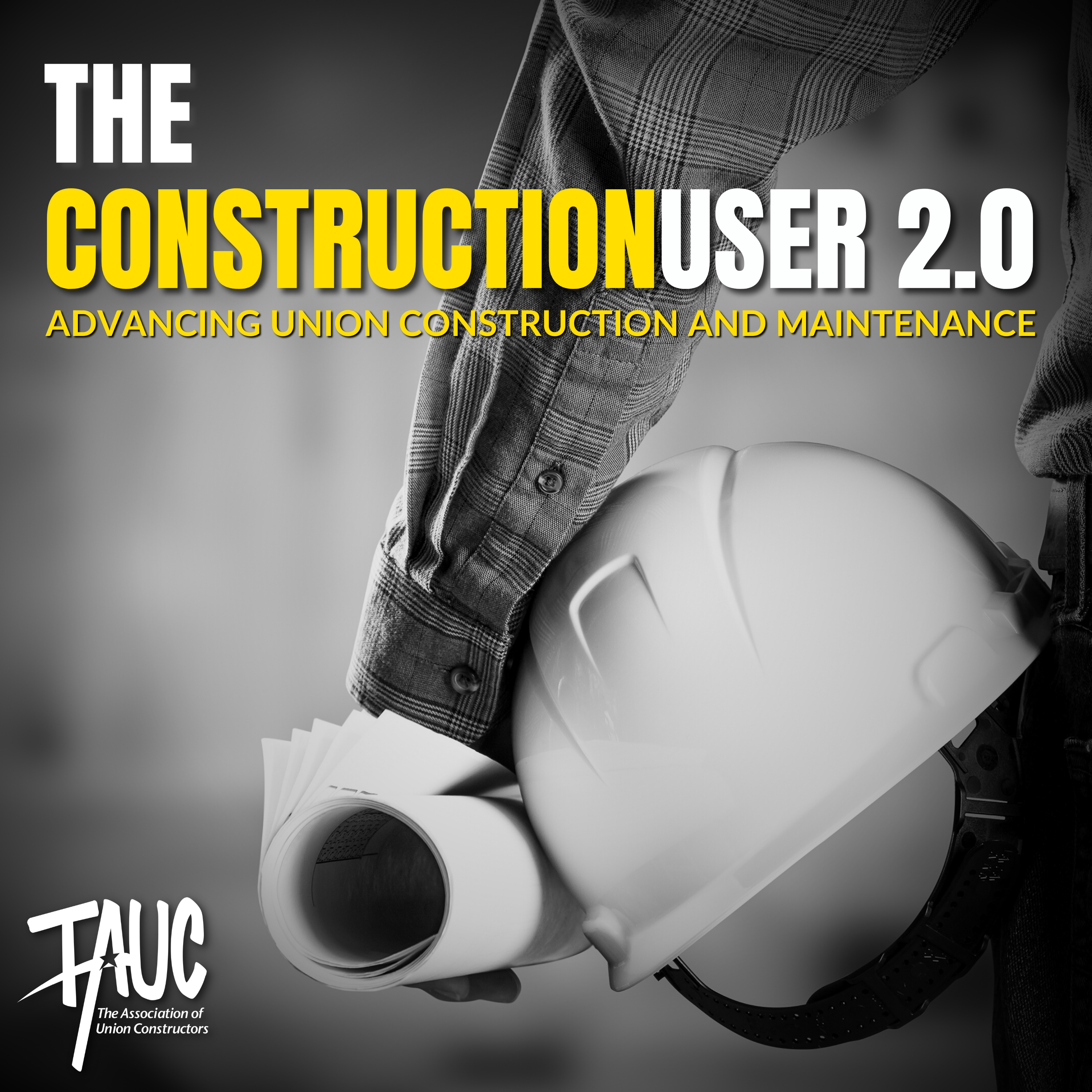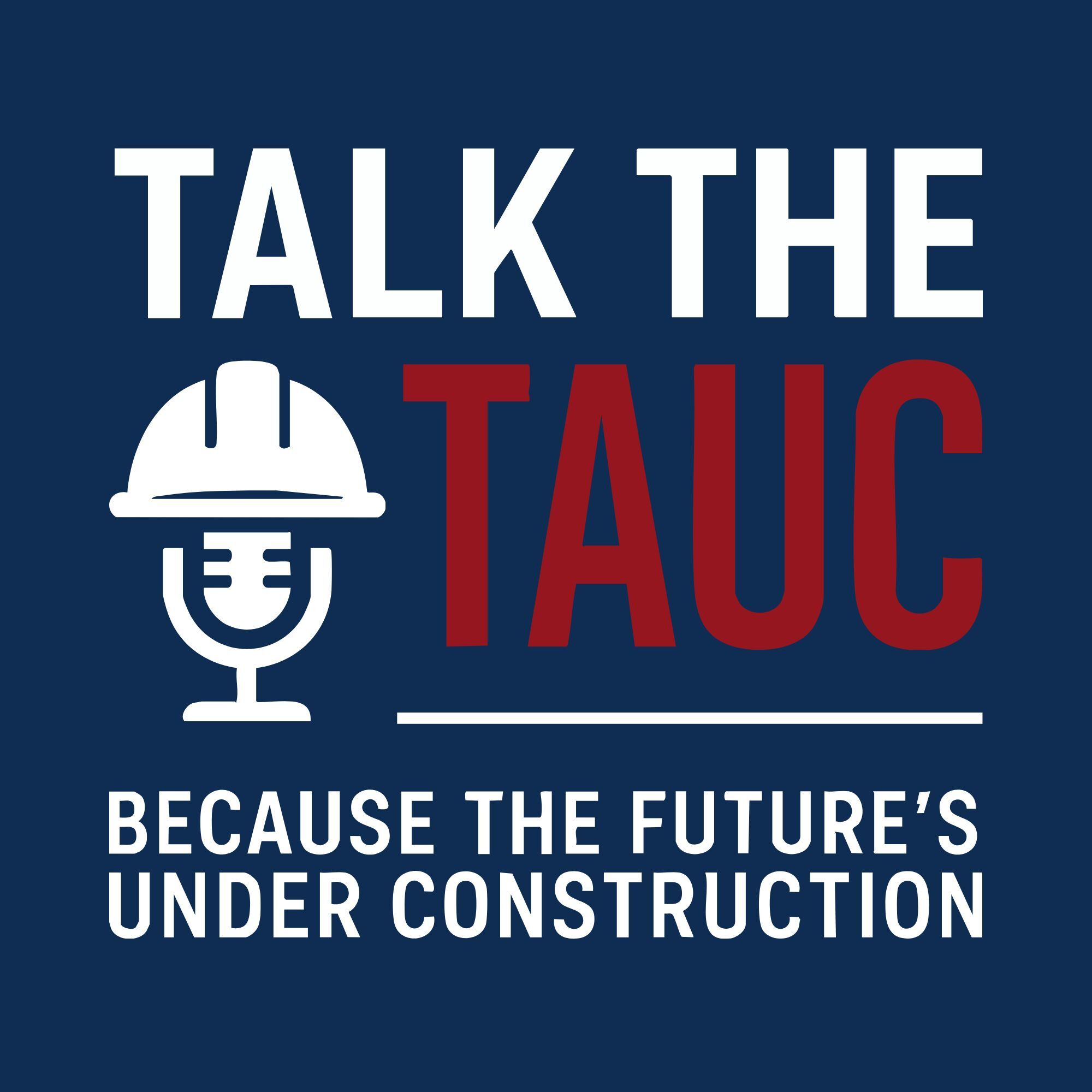Episode Transcript
Welcome to The Construction User 2.0 from the Association of Union Constructors. In this podcast we explore the latest labor trends, industry insights, and important issues in the world of construction. Join us for conversations with industry leaders, subject matter experts, and innovative visionaries as we discuss how we are building the world of tomorrow.
Kurt: What is the Association of Union Constructors working on? Where do they fit into the grand scheme of the construction industry?
Daniel: Yeah, TAUC, aka The Association of Union Constructors I think is still in its infancy. When it was originally conceived it was born from the National Erectors’ Association back in 2007. The NEA or the National Erectors’ Association had been around since 1969. They created this product known as the National Maintenance Agreements, which you’d already introduced. It's a series of 14 collective bargaining agreements that is used in the heavy industrial sector throughout the United States and some of its territories.
Since ’69, ’71, the NMA was born as a product of the National Erectors’ Association. It started to gain momentum with the building trades and their participating crafts to the point where the product, the baby, the NMA, actually had become stronger than the parent, which was the NEA. In the early 2000’s, it became clear that there was really a lack of a true multi-craft union only contractor association in the United States. There’s another bigger group out there that we won’t name that has become, it’s a little bit crude, but bipolar. The non-union side has cannibalized it and taken it over.
In 2007, the association TAUC was born and we’re still trying to get our feet under us and get pulling at 100%, but got a young leadership team. A lot of good volunteers sit on our board. They're going to help us take it to the next level. That is to be the true voice of all union contractors or constructors in the United States.
Kurt: Nice. I like that. It’s been an interesting journey for me as well, because you hear a lot of—there are all these organizations, which I won’t name. I’ll forget some and then they’ll feel like, why did you mention them and not us? There are all these single craft associations. They are for this trade, or this trade or this trade, but I think we’re kind of one of the only multi-trade on the management side.
Daniel: Yeah. Like I said, there's a bigger one out there that maybe represents about 20% of their book that’s union. With regards to the MEP contractors’ associations that you identify, The Mechanical Contractors’ Association, The National Electrical Contractors’ Association and SMACNA. Those are the three larger national contractors’ associations in the US that are all exclusively union and they do a great job. They do a great job representing their specific disciplines.
But as I indicated, that cohesive glue that brings multi-craft contractors and their specialty subcontractors together, there wasn’t a union exclusive group that was doing that up until ’07. That’s why we’ve got you in our marketing department to spread the gospel of what we are, who we are and what we’re capable of doing if we continue to unite together and drive towards effecting change.
Kurt: You opened up for this question of we have all these other organizations, they're big, some are union, some are nonunion. What would be the benefit for an owner? Why sign a PLA, a multi-craft project labor agreement? Why go union as opposed to not?
Daniel: Sure. Well, bottom line is it’s because we’re the best performers out there in our industry. Most skilled, trained, educated folks that you can possibly get, these men and women have spent, the majority of them, a four year, equivalent of a bachelor’s degree in apprenticeship program learning their discipline while at the same time getting on the job training, and access to these individuals in large quantities. It’s a network of local unions that are glued together by their international, so they can transport folks from an area where there’s less work to areas where there's more work.
If you're a contractor, which ultimately is going to benefit the owner client, having access to that large available pool of skilled labor, the top percent. It’s going to translate into more effective execution of the work, efficiency. Safety obviously being a big part of that. But in addition, it’s almost like the Japanese model of just in time. If you're a contractor, and you’ve got a project, you're loaded up, that job is going well, you then start to scale down as the project comes to completion.
In the construction industry, they're all temporary jobs. They're not full time employment jobs. You're there until the job is over and then you go on to the next one. Going back to what I was referring to, if you're a contractor, why would you want to carry all that overhead, if you are going to have lulls in between potential next projects? Keeping 100 or 500 or a few thousand men and women, crafts people on your payroll with them not producing any product just doesn’t seem efficient. If you don’t have them on your payroll, meaning you're not paying them, they're going to look for a job elsewhere.
The benefit of a hiring hall is key to the union construction industry and ultimately benefits the owner, because that makes our contractors more cost effective with their ability to reduce their overhead, provide efficiencies when they're putting their bid packages together to these owner clients. The entire industry wins.
Kurt: Talk to me about the alternative. Obviously, you know we’ve worked together for a minute but I'm an entrepreneur. I just started and sold a bunch of different companies. I've invented a new widget, it’s a brand new widget, it’s going to a new factory. Obviously, this is happening all over. I invented this new widget. It’s a new way to do something. It's a $100 million plan. It’s going to need multi-trades. It’s going to need a lot of support. What’s the alternative to a union hall? Craigslist?
Daniel: I don’t know, honestly. There are unorganized networks, I'm sure that can provide access to people but you don’t know what you're going to get at the end of the day, where if you are going through a hiring hall, 95% to 99% of the time, you know the baseline skillset that these people are going to be able to bring to the table, because as I indicated, they’ve gone through or in the process of going through a standardized curriculum or standardized apprenticeship program, that in most cases, I'm going to say almost every single case are all registered with either state or the Federal Department of Labor.
It is a curriculum that’s established. Everyone has to go through it. You have to meet these minimum criterias in order to move one and to graduate, if you will, to become a full time journeyperson. The alternative? Maybe they're posting up at Home Depot on the corner trying to find available skill sets and I'm not saying that in jest, it’s the truth. When you hear about some of these developers, or some of these owner clients that are all about the bottom line and making sure that they have the most low scale of cost.
You're going to get what you pay for at the end of the day and people scramble to find those work opportunities that maybe haven’t gone through the rigorous training and exposure to what our union industry provides.
Kurt: To put that in the perspective of that individual. You have that guy who’s looking for construction opportunities or jobs needed, CDL, these people that are out there advertising those jobs, what’s in it for them? If you're the worker, not the owner client, not the contractor, you are Joe the plumber, to use the political trope, why go union?
Daniel: As an employee, as a prospective member of a local, as I stated earlier it’s the middle class jobs. If you are interested in working a full day’s work for more than a fair day’s pay, our industry is about to explode. We’ve done some research and there’s roughly upwards of 110 mega projects that are kicking off in 2023 alone. Mega project being defined as a construction job that’s going to be a $1 billion or more. A large number of those are multiple billions of dollars.
This year alone, there's 110 mega projects that are going to be kicking off. A lot of those are in the heavy industrial side of the industry. That doesn’t account for all the ongoing work that exists in our industry on a daily basis. Without this large resurgence of re-on-shoring of manufacturing facilities. The electro-mobility challenge that’s taking place. The race between all these automotive companies, about the only good thing that came out of Covid was the realization that our supply chains were too tight and too pinched.
We’re seeing reinvestment taking place here in America where we consume so much product. If you take 2023 and extend it to 2024, there is with a high level of certainty over 140 mega projects that are going to be starting or underway as we speak. In addition to that, as a result of the Covid anti-inflation reduction act, the CHIPS Act, all these government funding mechanisms that are now out there. There's over $1.2 trillion worth of incentive investment that the federal government is stimulating our economy with.
President Biden, back in 2022 signed an executive order that said that any project that has federal funding, over the amount of $35 million, will have a project labor agreement on it. That's $1.2 trillion worth of work and this is apart from everything that’s already taking place. The Infrastructure Act as well, but that’s one of those three bills that got passed that’s providing that funding. Why union? Well, project labor agreements require that these contractors are executing this work under project labor agreements. That’s driven by the owner who is more than likely accepting these government funds.
There's going to be a huge resurgence of opportunities in the construction industry and we don’t see it waning anytime soon. If someone was interested in finding a middle class ticket or securing and ensuring that they remain in the middle class, given what inflation is doing, the union side of the business right now is opening the doors to everyone. Middle class jobs, great pay, as I indicated, retirement benefits, where you're going to get a check until the day that you die and your surviving spouse could also benefit from that afterwards. As well as healthcare that goes for your family. There's not going to be a lack of opportunities in the next couple of years for anyone that’s interested in getting a middle class job in the construction industry.
Kurt: I have two different directions I can go with my next question, I want to know both. I read your OpEd a while back talking about—we talked owner clients first and then we went to the individual labor, but talk is mostly management and [inaudible 00:15:52] contractors…
Daniel: I do want to footnote that in that TAUC is a membership organization of, as you indicated, management representatives which predominantly are union contractors over 1700 currently. Also local employer organizations which we endearingly refer to as our local chapters that come from all different disciplines and walks of life, but at the same time and I'm not making this up, but the international unions, the labor representatives that participate on that National Maintenance Agreement, they're either the directors of constructions, vice presidents of the international unions, assistant general presidents of international unions, they consider TAUC to be their association as well.
We have this major buy in from labor as well because we are exclusively union, because we have their interest 9-1/2 times out of 10 at heart, our contractors and labor, that they consider TAUC to be their association as well.
Kurt: Thank you. That's a solid and good footnote plug. The question I have is there are people and like I said, I read your [inaudible 00:16:57] in response to one that called “unions” noncompetitive or anti-competitive. Can you respond to that a little bit here?
Daniel: I mean, if you're used to being king and can do whatever you want and get away with it and not have to worry about checks and balances, sure, it’s anti-competitive. You're not exclusively able to make all the decisions and determine who’s going to be successful and who’s not. When you bring in a collective system such as a labor management trust or a project labor agreement to set the guidelines for how you are going to engage with personnel, how are you going to treat them, what work rules they have to follow. It’s not business unfriendly, it’s just establishing the baseline, then guidelines for how we’re going to operate. Playing by the rule book, so to speak.
During the pandemic and leading up to where we are today, that’s becoming more favorable, especially with the younger generation that we’re trying to attract to our industry. They want to see their peers treated fairly and equitably as well.
Kurt: It’s funny when I read the original article—these anti-competitive policies, I was like, I have seen union contractors bid for a job, I wouldn’t call it noncompetitive. It’s just in a different league. It’s still a very competitive process.
Daniel: If you're on the B team, I'm going to say the union side is the A team, if you're on the B team, you're going to get abused if you worked for these entities.
Kurt: I think that’s fair. We’ve talked a little bit about it, but what about the future? Just wrapping it all up, unions got us here, we’ve established these trillions of dollars coming down the pipe, as today becomes tomorrow, as this year becomes next year, what does union construction or construction in America look like?
Daniel: It’s going to be dependent on how all of our parties interact and continue to drive for fairness and equality in the industry. Unions may do a great job in representing their people. Our contractors, they're top notch. They're not just bending over to all the whims and wills of an organization such as organized labor. They have to go out there and provide equity and value to their own organization when they're competing against other union contractors as well.
It’s really dependent upon bandwidth, personnel, both in and outside of a contractor’s office, the folks that they're engaging from a labor standpoint, but also the leadership teams that they have within their own organizations. Right now, everyone’s got massive backlogs. There's so much work on the books right now. It's insane. You hear stories about contractors actually passing up additional work opportunities because they don’t have frontline supervisors that they can entrust or ensure that a multimillion dollar project is going to go off without a hitch. Their glass is overflowing.
Two-fold, A, we need to find the next generation of craftspeople to bring into the industry so that we can ensure that our way will be successful in the long run. But also, our existing craftspeople, they need to look at starting their own organizations, they're own construction firms. Also, the folks that are maybe working with the tools, considering taking a management position, such as a superintendent, so that these contractors can continue to bid more work. Stepping out of the trenches if you will and becoming a sergeant, a foreman, a superintendent, on our vernacular.
Being that next leader. Those are the two items that I see being the biggest challenges for our industry as a contractor. Access to enough people to cover that $1.2 trillion worth of work that’s coming, in addition to everything else that’s happening from a private sector funding standpoint, but also the evolution of our current tradespeople to opening up their own organizations, their own firms, and a step beneath that becoming frontline supervisors.
Kurt: Awesome. Dan, thank you so much for giving me a moment of your morning to talk about some really cool stuff going on and there’s a lot of moving pieces. We appreciate you for loaning your voice.
Daniel: Most definitely. Thank you for the opportunity and this was fun. Let's do it again.
Kurt: Absolutely. Anytime.
You’ve just listened to The Construction User 2.0 from the Association of Union Constructors. Don’t forget to subscribe to get all future episodes of what is going on and what is current in the Union Construction and Maintenance industry.


